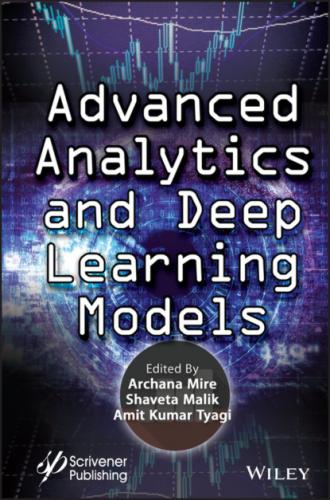Publishers at Scrivener Martin Scrivener ([email protected]) Phillip Carmical ([email protected])
Advanced Analytics and Deep Learning Models
Edited by
Archana Mire
Computer Engineering Department, Terna Engineering College, Navi Mumbai, India
Shaveta Malik
Computer Engineering Department, Terna Engineering College, Nerul, India
and
Amit Kumar Tyagi
Vellore Institute of Technology (VIT), Chennai Campus, India
This edition first published 2022 by John Wiley & Sons, Inc., 111 River Street, Hoboken, NJ 07030, USA and Scrivener Publishing LLC, 100 Cummings Center, Suite 541J, Beverly, MA 01915, USA © 2022 Scrivener Publishing LLC For more information about Scrivener publications please visit www.scrivenerpublishing.com.
All rights reserved. No part of this publication may be reproduced, stored in a retrieval system, or transmitted, in any form or by any means, electronic, mechanical, photocopying, recording, or otherwise, except as permitted by law. Advice on how to obtain permission to reuse material from this title is available at http://www.wiley.com/go/permissions.
Wiley Global Headquarters 111 River Street, Hoboken, NJ 07030, USA
For details of our global editorial offices, customer services, and more information about Wiley products visit us at www.wiley.com.
Limit of Liability/Disclaimer of Warranty While the publisher and authors have used their best efforts in preparing this work, they make no representations or warranties with respect to the accuracy or completeness of the contents of this work and specifically disclaim all warranties, including without limitation any implied warranties of merchant-ability or fitness for a particular purpose. No warranty may be created or extended by sales representatives, written sales materials, or promotional statements for this work. The fact that an organization, website, or product is referred to in this work as a citation and/or potential source of further information does not mean that the publisher and authors endorse the information or services the organization, website, or product may provide or recommendations it may make. This work is sold with the understanding that the publisher is not engaged in rendering professional services. The advice and strategies contained herein may not be suitable for your situation. You should consult with a specialist where appropriate. Neither the publisher nor authors shall be liable for any loss of profit or any other commercial damages, including but not limited to special, incidental, consequential, or other damages. Further, readers should be aware that websites listed in this work may have changed or disappeared between when this work was written and when it is read.
Library of Congress Cataloging-in-Publication Data
ISBN 978-1-119-79175-1
Cover image: Pixabay.Com Cover design by Russell Richardson
Set in size of 11pt and Minion Pro by Manila Typesetting Company, Makati, Philippines
Printed in the USA
10 9 8 7 6 5 4 3 2 1
Preface
Advanced analytics is a mixture of machine learning, artificial intelligence, graphs, text mining, data mining, semantic analysis. It is an approach to data analysis. Beyond the traditional business intelligence, it is a semi and autonomous analysis of data by using different techniques and tools. However, deep learning and data analysis both are the high centres of data science. Almost all the private and public organizations collect heavy amounts of data, i.e., domain specific data. Many small/large companies are exploring large amounts of data for existing and future technology. Deep learning is also exploring large amounts of unsupervised data.
In fact, it is a key benefit of big data. It is also effective for big data. Moreover, it is collecting an unlabelled and uncategorized raw data. There are some challenges also in big data related to the extraction complex patterns from the large amount of data, retrieving of fast information, tagging of data etc, deep learning can be used to deal these kinds of problems or challenges.
The purpose of this book is to help teachers to instruct the concepts of analytics in deep learning and how big data technologies are managing massive amounts of data with the help of Artificial Intelligence (AI), Machine Learning (ML), Deep Learning (DL) etc. In this book one will find the utility and challenges of big data. Those who are keen to learn the different models of deep learning, the connection between AI, ML and DL will definitely find this book as a great source of knowledge.
This book contains chapters on artificial intelligence, machine learning, deep learning and their uses in many useful sectors like stock market prediction, recommendation system for better service selection, ehealthcare, telemedicine, transportation. In last few interesting chapter like innovations or issue or future opportunities with fog computing/cloud computing or artificial intelligence are being discussed in this work for future readers/researchers.
Hence, this book will be convenient to the undergraduate and graduate students planning their careers in either industry or research. This will also serve as a great source of learning to software engineers who are beginners in the field of advanced analytics in deep learning.
Dr. Archana MireDr. Shaveta MalikDr. Amit Kumar Tyagi January 2022
1
Artificial Intelligence in Language Learning: Practices and Prospects
Khushboo Kuddus
School of Humanities (English), KIIT Deemed to be University, Bhubaneswar, Odisha, India
Abstract
Fourth Industrial Revolution which features rapid expansion of technology and digital application is influencing almost all spheres of our lives. Artificial Intelligence (AI) has made an impact on the way we live and work, that is, from floor cleaning to instructing Alexa. AI has a great potential in the field of education. AI in education is an emerging field in educational technology. It has an enormous
